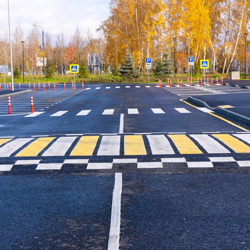Have you ever driven over a raised section of the road and wondered if it was a speed bump or a speed hump? These traffic calming devices are often confused, but understanding the differences can help you make informed decisions for traffic safety in your area. Let’s dive into the distinctions between speed bumps and speed humps and their specific uses.
Understanding Speed Bumps and Speed Humps
What Are Speed Bumps?
- Definition and Dimensions: Speed bumps are narrow, raised sections of pavement designed to slow vehicles to around 5-10 mph. They are typically 3-4 inches high and 12 inches wide, causing a sharp jolt when crossed at speed.
- Common Uses: Found in parking lots, private roads, and areas with heavy pedestrian traffic, such as near schools or parks.
- Advantages and Disadvantages: While effective at reducing speed, they can be uncomfortable for drivers and may cause wear and tear on vehicles.
What Are Speed Humps?
- Definition and Dimensions: Speed humps are broader and more gradual than speed bumps, usually 10-14 feet wide and about 3 inches high. They slow vehicles to 15-20 mph.
- Common Uses: Often used on residential streets and areas where a smoother ride is preferred, such as near hospitals or residential complexes.
- Advantages and Disadvantages: Speed humps provide a gentler experience for drivers while still slowing traffic. However, they may not reduce speed as drastically as speed bumps.
Key Differences and Applications
- Design and Comfort: Speed bumps cause a more abrupt slowdown, suitable for very low-speed areas. Speed humps offer a smoother transition, making them ideal for maintaining a moderate speed in residential areas.
- Speed Reduction Effectiveness: Speed bumps are more effective in drastically reducing speed, whereas speed humps offer a balance between slowing down traffic and maintaining a smooth ride.
- Use Cases and Best Practices: Discuss scenarios where each type is preferable, considering factors like road type, traffic volume, and community needs.
Choosing the Right Solution for Your Community
- Assessment of Community Needs: Evaluate specific traffic issues, such as speeding or pedestrian safety, to determine the most appropriate solution.
- Consulting with Experts: The importance of seeking advice from traffic engineers or consulting firms to ensure proper installation and effectiveness.

